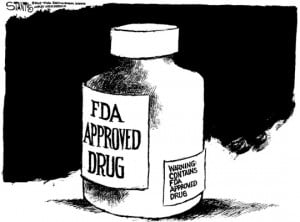How can improved quality control and diminishing quality control both work to save lives?
In the world of quality assurance, it is a rare thing to talk about quality within the public sector. The public assumes that quality exists but nothing is ever thought of in regards to the measures are needed to make sure things are done correctly. While reading this you will find two sides of the FDA. One side of the FDA ensures the safety of people through increased quality control measures. The other side of the FDA is hoping to remove some quality control measures in hopes of saving lives.
The FDA has begun rigorous efforts to take counterfeit and harmful drugs off of the internet. http://www.reuters.com/article/2012/10/04/us-fda-baddrugs-idUSBRE8930SN20121004
In a time of rising health care costs and pricey prescriptions, consumers have looked to various other sources to save money. A great source to purchase prescription medication is online. However, many of these online retailers are distributing “counterfeit and illegal” medicine. The FDA has joined forces with international regulatory and law enforcement agencies in an effort to take some of these dangerous drugs off the market. 18,000 online pharmacies have been shut down in the matter of just one week starting September 25th. This is essentially a form of quality checking within the public sector. The FDA is hoping to make sure that the medicines available to the public have gone through the testing process. All of these regulatory agencies are working towards a pharmaceutical industry with high standards of quality.
In contrast, the FDA is also working to remove some of the quality processes associated with the drug approval process. This comes mainly from a Republican push hoping to remove regulations across the board. These deregulations are not meant to send harmful drugs out on the market prematurely. This measure is hoping to assist immediately ill individuals that cannot wait through the testing process. The FDA has been doing this since the 1990’s. Currently patients within this characterization include aids and cancer patients. However, the FDA is hoping to include various other threatening diseases/conditions to this “accelerated approval” process. “Of 35 medicines termed innovative by the FDA and approved during fiscal 2011, 16 have some sort of shortened review or expedited approval” (Burton 2012). The key is that people with “life threatening” conditions are more willing to try riskier drugs. These people do not have the luxury of time to wait through the quality assurance process.
The point of this shows how quality assurance is paramount in some regards and in other circumstances it serves as handcuffs for progress. The latter tends to be rare but it does point out that too many regulations have harmful effects. We can clearly relate this to the upcoming elections as republicans and democrats battle over the topic of increased regulations. There are clear positives for both sides. Too many regulations impede progress and at times create a feeling of too much governmental control. Not enough regulations also have catastrophic results. Going back to the initial topic, if the FDA did not thoroughly check items that came through their department, people’s lives would be in danger. People would not be aware of the harmful side effects of the things they are ingesting. The perfect middle ground is a difficult thing to find and seems to be an ongoing battle within our society.
Sources:
http://online.wsj.com/article/SB10000872396390444083304578018790623838634.html
http://www.reuters.com/article/2012/10/04/us-fda-baddrugs-idUSBRE8930SN20121004
